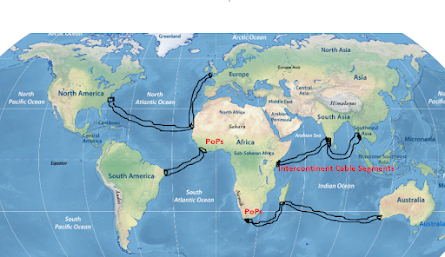Technology Disruption and the evolving XaaS business models, which are the next frontiers?
Technology has grown in leaps and bounds over the past 20-30 years, with a 360 degree shift from analog telephony and other traditional dial up services to a convergence of voice, video, data & internet services. This phenomenon is facilitated by the parallel growth trajectory of networks, starting from 2G towards 3G/4G/5G broadband networks, the increasing fiber footprint (Terrestrial, aerial and submarine) and the emergence of Data Center & cloud infrastructure. These network enhancements have enabled increased data speeds and improved subscriber experience. Obviously this network build comes with a massive CAPEX outlay and networks therefore end up adopting Vendor-lock-in and other preferential business models to recoup their investment.
Meanwhile, with increasing network coverage footprint has been growth in mobile broadband internet subscriptions, and a surge in the adoption and use of the smartphone, which is now becoming a necessity in all ways of life. According to GSMA data,In Sub Saharan Africa alone, there were about 300 million active smart phone users as of 2018, and forecast to rise to 686 million by 2025, as networks penetrate into the under-served and un-served areas. The adoption is also propelled by a young population demographic that craves for mobility, services 'on the go' and is generally 'hungry for 'data and internet'.
Network Service providers have therefore concentrated on pushing many services to the smartphone as they venture into new revenue frontiers, more so demonstrated by the growth in the use of digital financial services or mobile money , especially in sub Saharan Africa. As of 2019, there were 469 million registered mobile money accounts, with 181 million active accounts pushing close to $456.3 billion annually in diverse transactions of P2P transfers, International remittances, bulk & merchant payments, credit top-ups etc. This has caused disruption in the finance and banking sector, and is spreading fast into other sectors.
The smartphone adoption, mobile money service penetration and the availability of fast and secure internet are at the forefront of technology disruption, setting the stage for a revolution in several industries, with new and flexible technology powered business models. This article will specifically focus on the entertainment and content industry as the next technology disruption frontier.
The Digital Terrestrial Television(DTT) & Satellite TV model
At the end of 2019, the whole of Africa had a digital pay TV subscriber base of 30.9 million subscribers according to Digital TV Research and revenue of 5.48 billion USD. This is expected to rise to 47.26 million subscribers and to a revenue of USD 7.2 billion by 2025. Digital satellite content providers like DSTV, Canal+, Startimes are some of the main pay TV companies in Africa. Their services are based on a bouquet model, which gives subscribers access to segmented entertainment channels based on a monthly subscription.
Now, the above numbers while seemingly huge, point to a large population being locked out of this segment. And the main reason for this is affordability. For example, a premium bouquet from DSTV, which gives access to many entertainment and sports channels, including English premier league content that is very popular in Africa, costs about USD 60 per month in Uganda.
By contrast, a Netflix premium subscription, available on the go, on any device, costs about USD 18 per month. Amazon, an equivalent content provider, charges USD5.99 for access to prime video content or an equivalent of USD10.19 in UK per month for a package that includes access to the English Premier League.
The Data Centre and Cloud models(XaaS)
The above facts reveal an interesting investment opportunity in data centre and cloud architectures. These investments are required to support storage and staging requirements for audio & video content as well as platforms for application service providers to provide user interface applications like Android, Apple & web. This will enable the re-engineering of business models that target a wider mobile broadband internet subscriber base, which is expected to rise from 250 million in 2019 to 483 million by 2025 in sub Saharan Africa.
The Data center /Cloud model, with network function virtualization(NFV) features has the ability to run several Applications, Operating systems and Storage areas, opening the door for multi-tiered business models in what is generally termed as Anything-as-a-service(XaaS). Several sub-models based on the same priciple have emerged, i.e Infrastructure as a service(IaaS), disaster recovery as a service(DRaaS), Software as a Service(SaaS), Platform as a Service(PaaS), Mobile Backend as a service(MBaaS) and so on. This model reduces enterprise I.T budgets & the Total Cost of Ownership(TCO) as enterprises and private players do not have to invest in server hardware or worry about utility bills, but rather focus on their core business operations.
Mass Market Premium Content model
While cognizant of the average revenue per user (ARPU) and spending thresholds for subscribers in Africa, lets assume that just 30% of the mobile broadband internet subscriber base are able to subscribe, for 1 USD to a premium On-Demand channel that includes the English premier league every weekend. All factors constant, this would represent about USD 145 million gross revenue every weekend by 2025, which amounts to about USD 5.5 billion in annual revenue over the premier league season. This is just one example but it represents a bankable opportunity in this space, especially as the percentage of subscriptions increases, local content aggregation improves and the connectivity gap is narrowed. Assuming the subscribers pay an additional 1 USD for other content, the projected gross revenue doubles to USD 11 billion.
Conclusion
It seems inevitable, based on the above facts, that one of the next technology disruption frontiers is in the entertainment/ content industry in Africa. This disruption is one that is powered by increased mobile broadband subscriptions, the ability to pay for services digitally using mobile money and the availability of distributed Data Centers on the continent.



Comments
Post a Comment